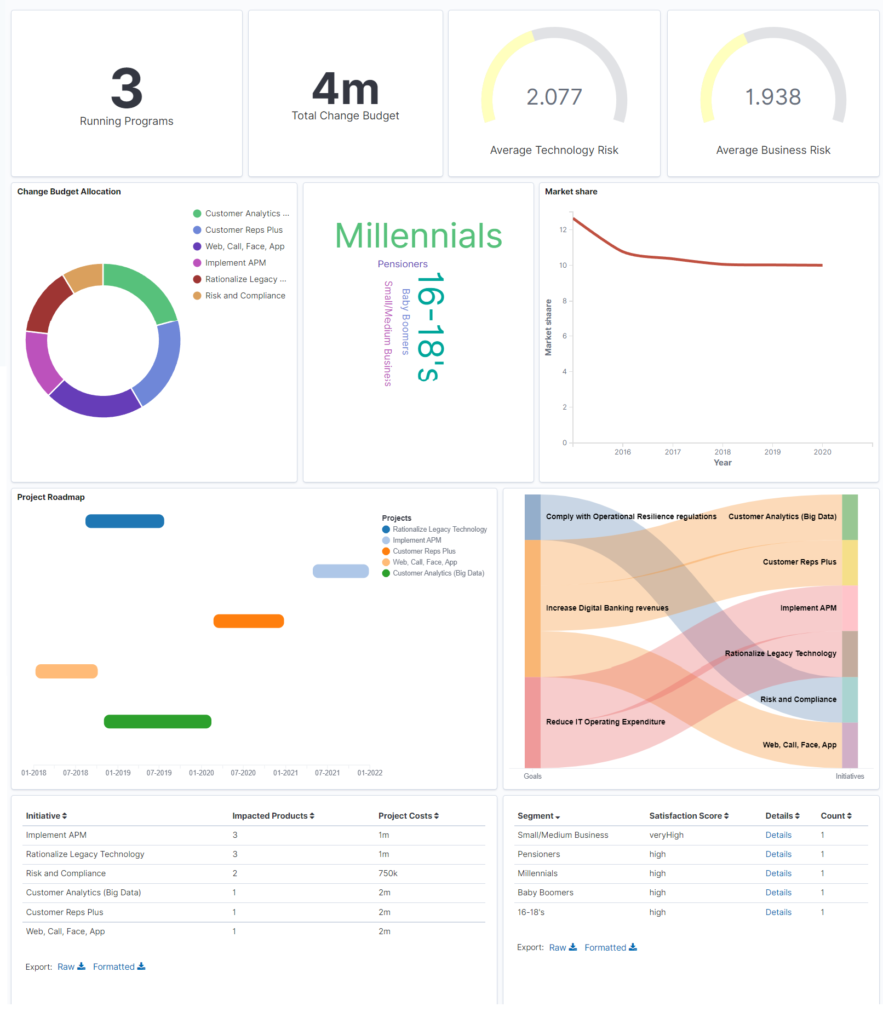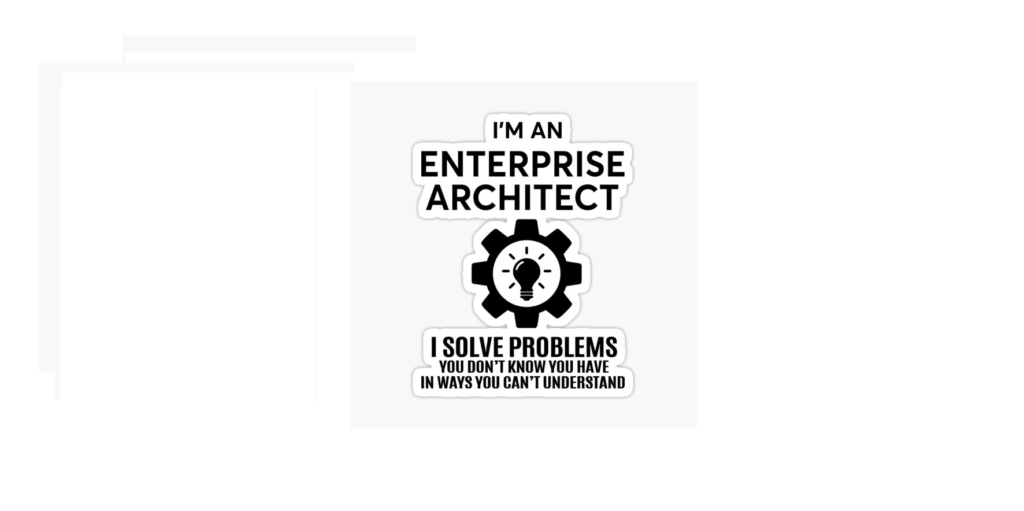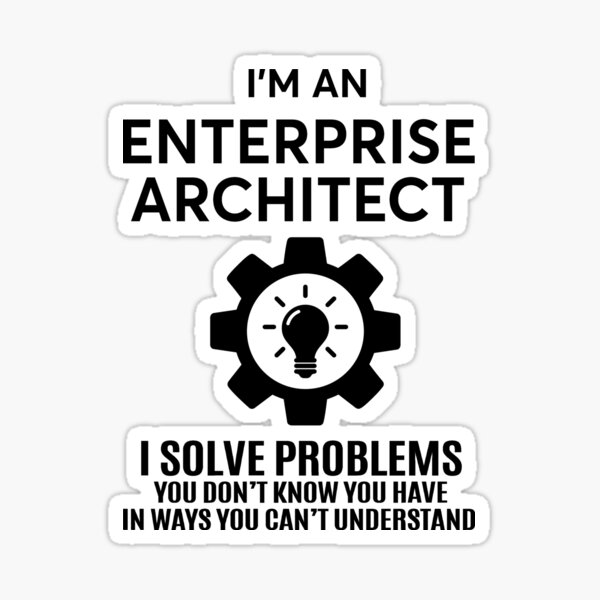
Solution ≠ Enterprise Architecture
Audience: management / visionary
Holistic Enterprise Architecture (HEA for short) is an ever-expanding discipline, especially in developed countries in the environment of large companies from various fields of activity, such as telecommunications, banking, energy, automotive, government and technology companies themselves. Within Central Europe, HEA is still in its infancy. Several companies in the region already have gradually developing HEA departments. In other companies, the sub-processes involved by HEA are carried out, but without mutual coordination and management. Unfortunately, the most recurring situation is the state in which the organization is unable to answer trivial questions which are necessary for its operations, such as: Which physical server will cause which services to fail? And which service consumers will be affected?
Incorrect interpretation of Solution and Enterprise architecture
And these are the questions that Holistic Enterprise Architecture can reliably answer and provide not only the answers themselves, but also the proposal for improvement, the delivery plan and the necessary supply management itself. In the region of Central Europe, terms Solution Architecture and Enterprise Architecture are often mistaken. Most IT systems companies, whether for their own use or for their customers, have a Solution Architecture department or team. Its purpose is, simply put, to ensure that what the business (customer) has ordered is delivered in accordance with the defined requirements and in the required quality, budget and time. Business is an important concept. Enterprise Architecture has a similar goal to Solution Architecture, namely create value for business through technology. However, Enterprise Architecture focuses on the entire organization, not a single IT system. It creates the so-called big picture of organization with emphasis on set strategic goals, motivation, business processes and structure of the organization, IT services, applications and infrastructure on which they are deployed. In addition, in specific segments, it also examines the production factories, materials, or equipment of the organization and much more. Its basic goal is to objectify the reality of the organization and to connect all relevant components in a certain level of abstraction. The mentioned level of abstraction may be different for individual organizations. In principle, however, Enterprise Architecture will not examine and objectify all the chairs and desks that are in the organization's offices. Rather, Enterprise Architecture focuses on the organization's stated strategy, long-term and short-term goals, and examines the current status of each relevant business process, IT service, and application that supports its operation and the physical devices that run the application. It then evaluates the current state (big picture) and suggests improvements for the target state, ie the moment in time to which the organization wants to go. The actual implementation of deliveries of partial IT solutions for the target state of the organization can already be carried out by Solution Architecture teams (as a result, Enterprise Architecture includes, among other things, Solution Architecture). By this cyclic procedure Enterprise Architecture can reduce costs, eliminate redundant IT systems / processes / infrastructure, optimize processes and practically the entire organization. Enterprise Architecture can be divided by domains into several parts such as business architecture, application architecture, data architecture, or technology architecture. As their names suggest, each addresses a specific domain of the organization. Due to the different maturity of the organization and its Enterprise Architecture department, Enterprise Architecture itself can include only some of the above parts, most often application and technology architecture.
Holistic view of the organization, including interconnections - HEA
The term Holistic which is added to the term Enterprise Architecture, means nothing more than that Enterprise Architecture deals with the organization as a whole and examines all parts of Enterprise Architecture, often not necessarily trying to find the exact boundaries between domains.
Common issues facing the companies we are discussing with Holistic Enterprise Architecture include:
- data fragmentation in separate systems,
- the absence of interconnection of this data,
- manual data management,
- outdated data,
- absence of standardization.
These problems are associated with negative impacts such as enormous amounts of manual work, duplicate systems and processes, unconsolidated data, cost, long and often unsatisfactory delivery of changes. The holistic Enterprise Architecture clearly makes it possible to prevent these problems and impacts. At this point, one would argue that while HEA is of great benefit, its implementation in a low-maturity organization is too costly. "We don't have enough money to afford not to have Enterprise Architecture," this paraphrase of the well-known quote adequately captures HEA's cost. On the one hand, there are the investments needed to implement HEA, on the other hand, there are the costs and risks that arise due to the absence of HEA.
The beginnings of Holistic Enterprise Architecture in an organization
Once the organization understands the necessity of Enterprise Architecture, it starts the process of implementing it. However, the first mistakes in this process often occur, which ultimately result in either an inadequate cost ratio for Enterprise Architecture and its benefits, or worse, a total failure of Enterprise Architecture.
HEA should be implemented in any major organization that has a non-trivial number of processes and IT systems that support their operation. Enterprise Architecture should be seen not only as a discipline, but also as a department and a process. Department of Enterprise Architecture, except for team members, also needs a collaborative platform, within which Enterprise Architectural models will be created, including objectified and interconnected data of the organization (mentioned big picture). Enterprise Architecture as a discipline offers a wide range of reference models for different sectors. Through them, it is possible to use various standardized models. However, despite the use of such reference models, the first mistake is laboriousness and time inefficiency (understand the lengthy implementation processes and late benefits, if any) that often accompanies HEA implementation.
One of the first steps in implementing HEA in an organization is to identify data sources. Many companies focus only on the subset of data that really needs to be consolidated in Enterprise Architectural Models. A common example is focusing only on the application portfolio and the absence of cost data or operational and monitoring data on these applications. This is where the second significant mistake occurs, when the necessary data is missing in the Enterprise Architectural Models.
Last but not least, in the beginnings of Enterprise Architecture, there is an inappropriate setting of Enterprise Architectural processes. As a result, duplication of data begins to emerge over time and the models themselves become confusing and unsustainable. In addition, improperly set up processes prevent stakeholders from collaborating with each other. Stakeholders in this case are not only the Enterprise Architects themselves, but also the managers, DevOps, Solution Architects and many other roles who are more or less involved in Enterprise Architecture. Some of them act as consumers of data when information from Enterprise Architecture is needed for decision making. Others act as data brokers (DevOps) or work directly with this data (Enterprise Architects). At the same time, with the growing volume of data in Enterprise Architectural Models, the complexity is also increasing, but it is realistic in the environment of large organizations, ie it is not only part of the models themselves. It is important to correctly describe this real complexity through Enterprise Architectural Models, and simplification cannot be linear. On the contrary, all necessary links between elements of objectified reality must be maintained in the models. In other words, Excel tables are not enough… The third mistake is the lack of confidence in Enterprise Architectural Data and the inability to collaborate stakeholders.
A platform for the effective implementation and maintenance of Enterprise Architecture in an organization's ecosystem
BiZZdesign is a robust collaborative platform, the use of which helps prevent HEA implementation mistakes and eliminates the consequences of these mistakes. The BiZZdesign ecosystem describes the environment in which BiZZdesign can be implemented.
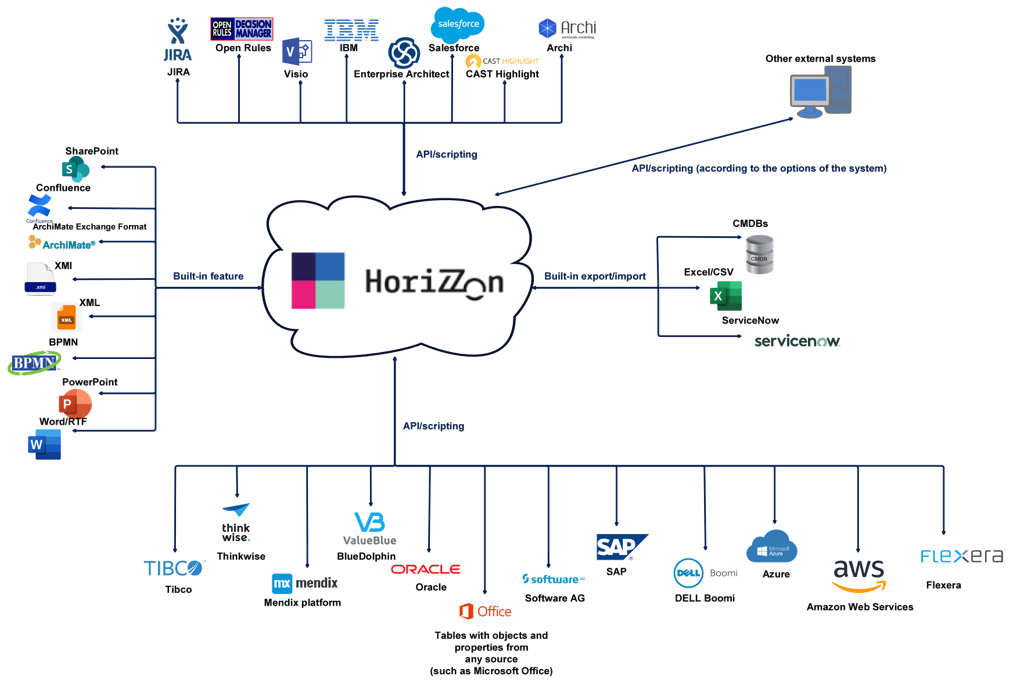
The BiZZdesign ecosystem provides an overview of built-in integrations and support for interchange formats. In addition, BiZZdesign has Open API (REST) and custom scripting language to ensure import (but also export) data from external systems at regular intervals. BiZZdesign this way creates Single Source of Truth, when consolidating enterprise architecturally relevant information from external, type-oriented applications such as CMDB, financial systems, CRM, DMS, SMS and other business systems. At the same time, Single Source of Truth provides objectification and connection of individual data into graphic models through:
- automation of creating views and diagrams,
- automatic identification of objects (protection against duplication),
over which it is possible perform various impact analyzes and manage protfolios for various data catalogs such as applications, processes, infrastructure and so on. With the use of such an implementation of the BiZZdesign platform in the environment of the organization, it is possible to avoid mistakes in the implementation of HEA. The collaboration itself is provided via the intuitive HoriZZon web platform, where all interested parties have access to real-time data, who can simultaneously interact with live and dynamic data through analytics, advanced visualizations, Explore, Inspect functionality, or dynamic dashboards.
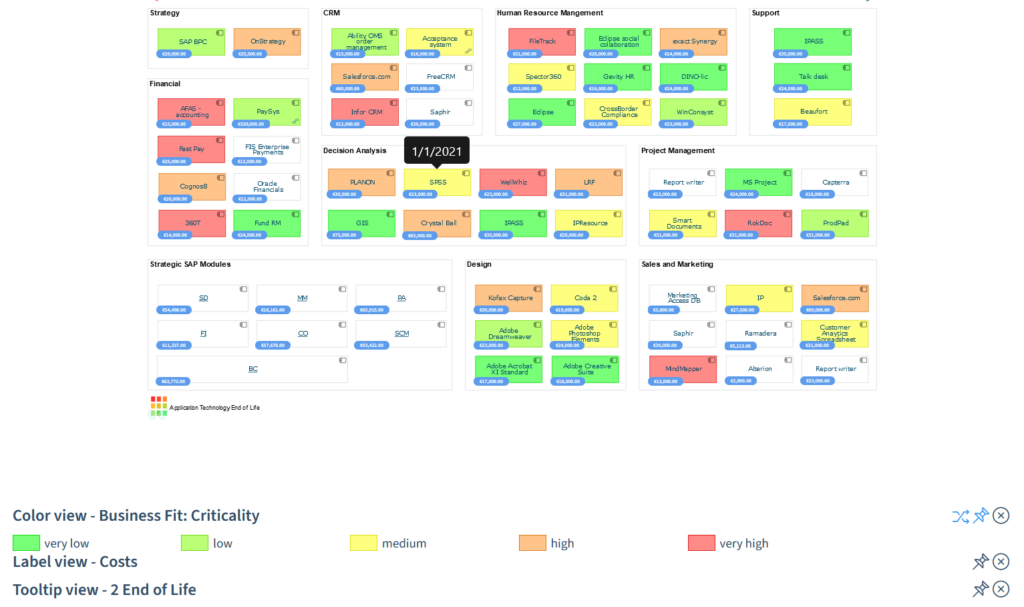
Understandable visualizations for business
The paradox of today's organization in many times is that business and IT operate as separate forces. IT often develops systems under its own auspices, with the owner directly from the IT department and based on IT requirements. However, this way of working is detrimental to organizations, as systems are developed regardless of business, many times unnecessarily. The IT department must work closely with the business because IT must develop systems to support the business, streamline, accelerate and optimize its operation, not the other way around. This phenomenon also brings with it a problem of communication between business and IT. The outputs generated by IT must be factual and understandable for business. BiZZdesign offers in this regard dynamic visualizations for different areas like Risk & Security, Customer Journey, BMC, Portfolio management and other. The most important are the use of data from the Enterprise Architectural Model catalogs in individual visualizations and the automatic identification of background conflicts (for example, in the visualization of application lifecycles and the infrastructure on which they are deployed). In this way, duplication in the Enterprise Architectural Model is avoided, all relevant interconnections from strategy to physical facilities are maintained, and meaningful information is provided to the business to support decision-making.
The problem described above is also related to the Enterprise Architecture department. Its position in the organization's structures varies from one company to another. When procuring Enterprise Architecturally necessary systems (whether it is a "Paint" or a platform), controlling enters into the decision-making process. Naturally, already within the first phases of the establishment of Enterprise Architecture of the organization, various roles from IT and business are integrated into the Enterprise Architecture department itself. Therefore, it is necessary from the beginning to emphasize that the individual outputs of Enterprise Architecture are understandable to all involved, including business.
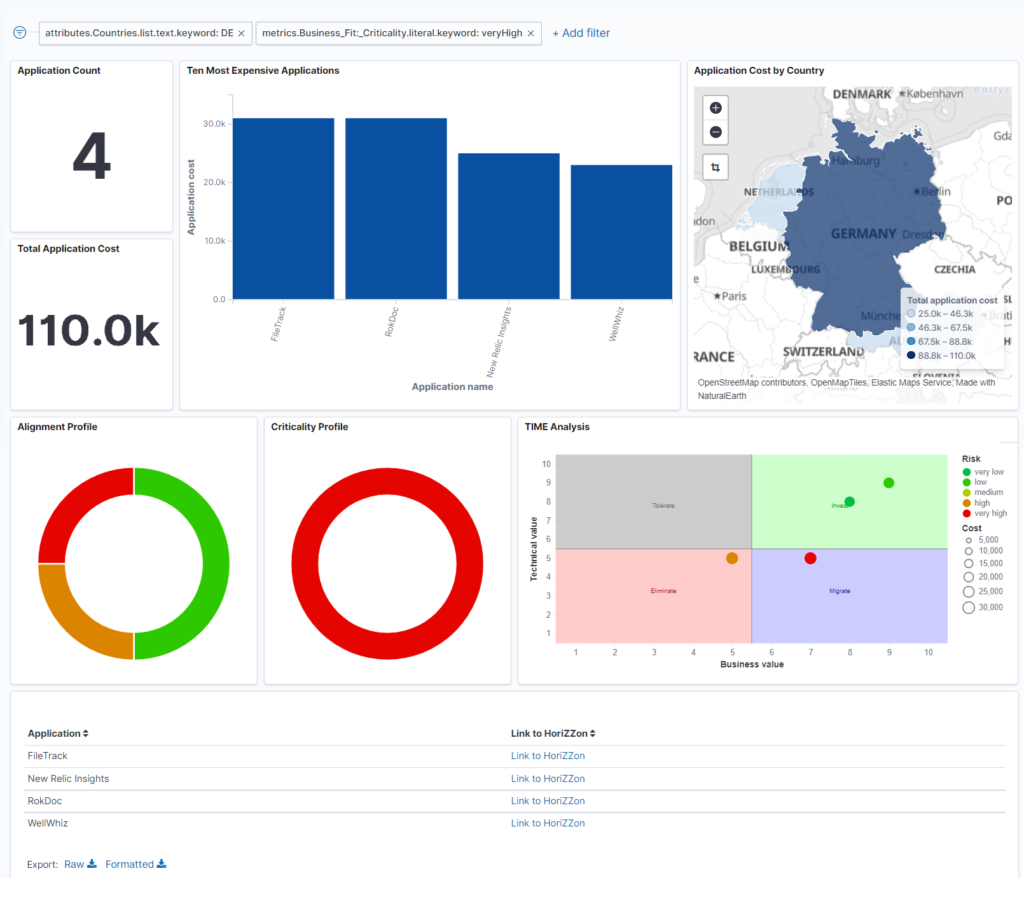
Holistic Enterprise Architecture is a necessary future for organizations not only in the Central European region. The need for an effective solution to growing complexity will bring with it an urgent need to invest in creating and improving Enterprise Architecture in the organization. The positive news that emerges from the experience of foreign corporate companies is that initial investments will return within a certain period in the form of eliminating risks and optimizing the costs associated with complexity itself.
